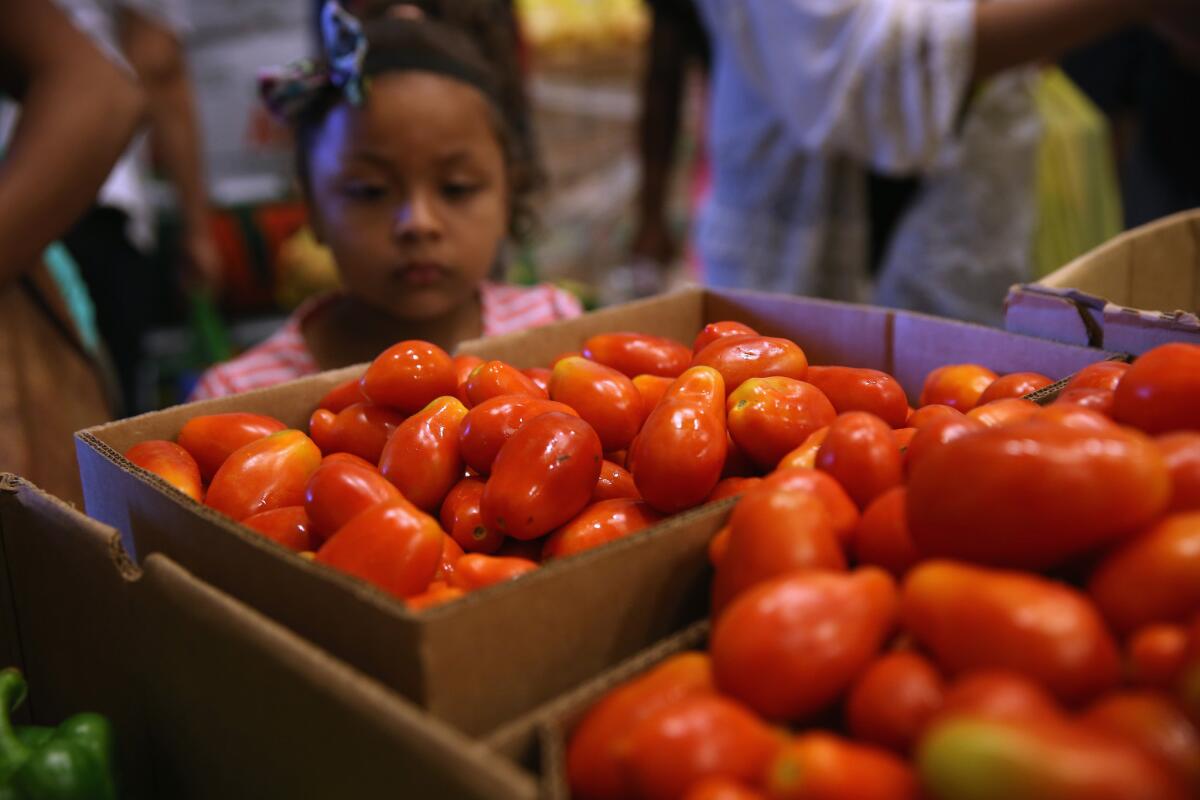Op-Ed: Living on $2 a day in America

Low-income families select free bread and produce at the Community Food Bank of New Jersey on Aug. 28 in Egg Harbor, N.J.
- Share via
When we first met Ashley, she was 19 and a new mom, living with her mother, brother, uncle and cousin in one of Baltimore’s public housing developments. Everyone in the home was out of work; no one was on welfare. The unit was furnished with only a three-legged table propped up against a wall, a ragged couch and one chair. The fridge was empty, the cupboards bare. Visibly depressed, Ashley’s hair was unkempt, and she was having difficulty supporting her baby’s head as she held her.
Ashley and her relatives were lucky in that the government was at least helping out with a place to live, but they lacked that crucial ingredient for survival in America: cash. This extended family had spent the last few months on cash income so meager that it added up to less than $2 per person per day.
Their story is far from unique. In fact, we estimate that in 2011 there were 1.5 million households with 3 million children scraping by on cash incomes of no more than $2 per person per day, up 130% from 15 years earlier. That’s about one of every 25 families with children living in a kind of poverty so deep that most Americans don’t think it even exists here.
How do families get by with so little? Noncash benefits like food stamps — now called SNAP — can go only so far. We’ve found that family members are perpetually at work — although without a job — in efforts to raise enough money to make it through the day.
Jessica Compton of Johnson City, Tenn., donates plasma as often as the law will allow for $30 a pop. There’s an obvious indentation at the crease of her arm, the result of so many needle pricks. Many among the $2-a-day poor bear these small scars.
Some months, Jennifer Hernandez in Chicago sells her SNAP — a felony — because she thinks it’s more important to have decent thrift-store clothes for her kids than it is for her to eat all the time.
Going without cash in the United States often means constantly looking for the next place to live, whether a homeless shelter or a friend’s couch. And sometimes it means trading sex for the ability to stay where you are for another night.
Many of these strategies constitute felonies, most come with serious risks, and all are time consuming. Forcing families to engage in activities such as these pushes them further and further out of the American mainstream, trapping them in abject poverty.
The rise of $2-a-day poverty is inextricably linked to the transformation of the social safety net that began 20 years ago. In the 1990s, President Clinton and Congress directed more cash resources to the working poor through programs such as the earned income tax credit, and sharply reduced cash aid to the very bottom of society.
Today, less than 1.3% of the U.S. population is on Temporary Assistance for Needy Families, or TANF — what many people call welfare. There are more avid postage stamp collectors in the country than welfare recipients. California is actually one of the more generous states when it comes to cash assistance for families with children. But there are nearly a million fewer people on California’s cash assistance rolls than there were 20 years ago.
Americans, on the whole, are suspicious of welfare. It goes against too many core American values. Ask Americans if we should do more to help poor families and a large majority will say yes. Ask them if we should give out more welfare and a majority will say no.
But it’s not simply a hatred of welfare that explains why it’s essentially dead. As a result of Clinton-era reforms, states can use federal funds not spent on cash assistance for other purposes, creating a powerful incentive to keep caseloads down. TANF is now effectively a welfare system for states, not for the people.
When we asked families living on virtually nothing what they wanted most, they said the chance to work a decent job. But sometimes work doesn’t work, and people need help.
We need to give a little cash to keep families from selling sex, selling SNAP, selling plasma to get a little cash. Cash allows people to purchase what they believe their families need most to succeed, and gives them the best chance possible to get out of their circumstances.
In exchange for her interview, Ashley received the standard $50 stipend, the most money she’d seen in months. Within 24 hours she’d purchased a home perm and styled her hair, and walked down to Goodwill to get a new pantsuit. Infant formula sat on the counter. Her baby in her mother’s care, Ashley headed out in her new outfit to apply for jobs. Earning just a little cash was all she needed to search for work.
H. Luke Shaefer is an associate professor at the University of Michigan School of Social Work and Gerald R. Ford School of Public Policy.
Kathryn Edin is a professor of sociology and public health at Johns Hopkins University. H. Luke Shaefer is an associate professor at the University of Michigan School of Social Work and Gerald R. Ford School of Public Policy. They are the coauthors of “$2.00 a Day: Living on Almost Nothing in America.”
Follow the Opinion section on Twitter @latimesopinion and Facebook
More to Read
A cure for the common opinion
Get thought-provoking perspectives with our weekly newsletter.
You may occasionally receive promotional content from the Los Angeles Times.









